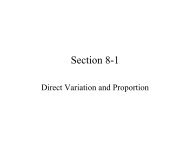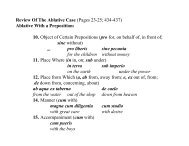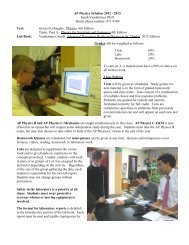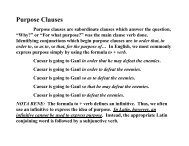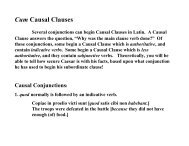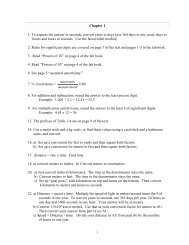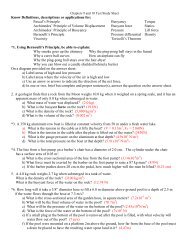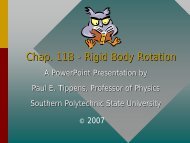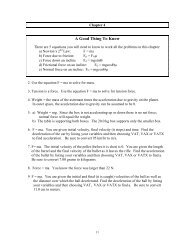Chapter 3B -- Vectors
Chapter 3B -- Vectors
Chapter 3B -- Vectors
Create successful ePaper yourself
Turn your PDF publications into a flip-book with our unique Google optimized e-Paper software.
<strong>Chapter</strong> <strong>3B</strong> - <strong>Vectors</strong><br />
A PowerPoint Presentation by<br />
Paul E. Tippens, Professor of Physics<br />
Southern Polytechnic State University<br />
© 2007
<strong>Vectors</strong><br />
Surveyors use accurate measures of<br />
magnitudes and directions to create<br />
scaled maps of large regions.
Objectives: After completing this<br />
module, you should be able to:<br />
• Demonstrate that you meet mathematics<br />
expectations: : unit analysis, algebra, scientific<br />
notation, and right-triangle triangle trigonometry.<br />
• Define and give examples of scalar and vector<br />
quantities.<br />
• Determine the components of a given vector.<br />
• Find the resultant of two or more vectors.
Expectations<br />
• You must be able convert units of<br />
measure for physical quantities.<br />
Convert 40 m/s into kilometers per hour.<br />
m 1 km 3600 s<br />
40--- x ---------- x -------- = 144 km/h<br />
s 1000 m 1 h
Expectations (Continued):<br />
• College algebra and simple formula<br />
manipulation are assumed.<br />
Example:<br />
x<br />
<br />
<br />
<br />
v0<br />
v f<br />
2<br />
<br />
t<br />
<br />
Solve for v o<br />
v<br />
0<br />
<br />
vt<br />
f<br />
<br />
t<br />
2x
Expectations (Continued)<br />
• You must be able to work in scientific<br />
notation.<br />
Evaluate the following:<br />
Gmm’ (6.67 x 10 -11 )(4 x 10 -3 )(2)<br />
F = -------- = ------------<br />
(8.77 x 10 -3 ) 2<br />
r 2<br />
F = 6.94 x 10 -9 -9 N = 6.94 nN
Expectations (Continued)<br />
• You must be familiar with SI prefixes<br />
The meter (m) 1 m = 1 x 10 0 m<br />
1 Gm = 1 x 10 9 m 1 nm = 1 x 10 -9 m<br />
1 Mm = 1 x 10 6 m 1 m = 1 x 10 -6 m<br />
1 km = 1 x 10 3 m 1 mm = 1 x 10 -3 m
y<br />
Expectations (Continued)<br />
• You must have mastered right-triangle<br />
triangle<br />
trigonometry.<br />
x<br />
R<br />
<br />
sin <br />
cos <br />
y<br />
R<br />
x<br />
R<br />
y = R sin <br />
x = R cos <br />
y<br />
tan R 2 = x 2 + y 2<br />
x
Mathematics Review<br />
If you feel you need to<br />
brush up on your<br />
mathematics skills, try<br />
the tutorial from Chap.<br />
2 on Mathematics. Trig<br />
is reviewed along with<br />
vectors in this module.<br />
Select Chap. 2 from the On-Line Learning<br />
Center in in Tippens—Student Edition
Physics is the Science of<br />
Measurement<br />
Length<br />
Weight<br />
Time<br />
We begin with the measurement of length:<br />
its magnitude and its direction.
Distance: A Scalar Quantity<br />
• Distance is is the length of the actual path<br />
taken by an object.<br />
A<br />
s = 20 m<br />
B<br />
A scalar quantity:<br />
Contains magnitude<br />
only and consists of a<br />
number and a unit.<br />
(20 m, 40 mi/h, 10 gal)
Displacement—A A Vector Quantity<br />
• Displacement is is the straight-line<br />
separation of two points in a specified<br />
direction.<br />
D = 12 m, 20 o<br />
A<br />
<br />
B<br />
A vector quantity:<br />
Contains magnitude<br />
AND direction, a<br />
number, unit & angle.<br />
(12 m, 30 0 ; 8 km/h, N)
Distance and Displacement<br />
• Displacement is is the x or y coordinate of<br />
position. Consider a car that travels 4<br />
m, E then 6 m, W.<br />
D<br />
4 m,E<br />
Net displacement:<br />
D = 2 m, W<br />
x = -2<br />
6 m,W<br />
x = +4<br />
What is the distance<br />
traveled?<br />
10 m !!
Identifying Direction<br />
A common way of identifying direction<br />
is is by reference to East, North, West,<br />
and South. (Locate points below.)<br />
N<br />
Length = 40 m<br />
40 m, 50 o N of E<br />
W<br />
50 o<br />
60 o 60 o 60 o<br />
E<br />
40 m, 60 o N of W<br />
40 m, 60 o W of S<br />
S<br />
40 m, 60 o S of E
Identifying Direction<br />
Write the angles shown below by using<br />
references to east, south, west, north.<br />
W<br />
N<br />
E<br />
45 o<br />
N<br />
S<br />
50 o<br />
W<br />
S<br />
E<br />
50 Click 0 S of to Esee the Answers 45 0 W . of . .<br />
N
<strong>Vectors</strong> and Polar Coordinates<br />
Polar coordinates ((R,) ) are an excellent<br />
way to to express vectors. Consider the<br />
vector 40 m, 50 0 N of of E, EE, for example.<br />
40 m<br />
90 o R<br />
90 o <br />
180 o<br />
50 o<br />
180 o<br />
270 o<br />
0 o<br />
270 o<br />
0 o<br />
R is the magnitude and is the direction.
<strong>Vectors</strong> and Polar Coordinates<br />
Polar coordinates ((R,) ) are given for each<br />
of four possible quadrants:<br />
210 o<br />
90 o<br />
120 o<br />
60 o 50 o<br />
0 o<br />
60<br />
60 o o<br />
(R,) ) = 40 m, 50 o<br />
(R,) ) = 40 m, 120 o<br />
180 o 270 o<br />
300 0<br />
(R,) ) = 40 m, 210 o<br />
(R,) ) = 40 m, 300 o
Rectangular Coordinates<br />
(-2, +3)<br />
-<br />
+<br />
y<br />
-<br />
(+3, +2)<br />
+<br />
x<br />
Reference is made to<br />
x and y axes, with +<br />
and - numbers to<br />
indicate position in<br />
space.<br />
Right, up = (+,+)<br />
Left, down = (-,-)<br />
(-1,<br />
-3)<br />
(+4, -3)<br />
(x,y) = (?, ?)
Trigonometry Review<br />
• Application of Trigonometry to <strong>Vectors</strong><br />
y<br />
Trigonometry<br />
x<br />
R<br />
<br />
sin <br />
cos <br />
y<br />
R<br />
x<br />
R<br />
y = R sin <br />
x = R cos <br />
y<br />
tan R 22 = x 22 + y 22<br />
x
Example 1: Find the height of a building<br />
if it casts a shadow 90 m long and the<br />
indicated angle is 30 o .<br />
The height h is opposite 30 0 and<br />
the known adjacent side is 90 m.<br />
h<br />
30 0<br />
90 m<br />
0<br />
tan 30<br />
<br />
opp<br />
adj<br />
<br />
h<br />
90 m<br />
h = (90 m) tan 30 o<br />
h = 57.7 m
Finding Components of <strong>Vectors</strong><br />
A component is the effect of a vector along<br />
other directions. The x and y components of<br />
the vector (R, are illustrated below.<br />
R<br />
<br />
x<br />
x = R cos <br />
y = R sin <br />
y<br />
Finding components:<br />
Polar to Rectangular Conversions
Example 2: A person walks 400 m in a<br />
direction of 30 o N of E. How far is the<br />
displacement east and how far north?<br />
N<br />
N<br />
R<br />
400 m<br />
y<br />
y = ?<br />
<br />
<br />
E<br />
x E<br />
x = ?<br />
The x-component (E) is ADJ:<br />
The y-component (N) is OPP:<br />
x = R cos <br />
y = R sin
Example 2 (Cont.): A 400-m walk in a<br />
direction of 30 o N of E. How far is the<br />
displacement east and how far north?<br />
N<br />
400 m<br />
<br />
x = ?<br />
y = ?<br />
E<br />
Note: x is the side<br />
adjacent to angle 30 0<br />
ADJ = HYP x Cos 30 0<br />
x = R cos <br />
x = (400 m) cos 30 o<br />
= +346 m, E<br />
The x-component x<br />
is:<br />
R x = +346 m
Example 2 (Cont.): A 400-m walk in a<br />
direction of 30 o N of E. How far is the<br />
displacement east and how far north?<br />
N<br />
400 m<br />
<br />
x = ?<br />
y = ?<br />
E<br />
Note: y is the side<br />
opposite to angle 30 0<br />
OPP = HYP x Sin 30 0<br />
y = R sin <br />
y = (400 m) sin 30 o<br />
= + 200 m, N<br />
The y-component y<br />
is:<br />
R y = +200 m
Example 2 (Cont.): A 400-m walk in a<br />
direction of 30 o N of E. How far is the<br />
displacement east and how far north?<br />
N<br />
400 m<br />
<br />
R x =<br />
+346 m<br />
R y =<br />
+200 m<br />
E<br />
The x- x and y- y<br />
components are<br />
each + in the<br />
first quadrant<br />
Solution: The person is displaced 346 m east<br />
and 200 m north of the original position.
Signs for Rectangular Coordinates<br />
90 o R<br />
<br />
+<br />
+<br />
0 o<br />
R is positive (+)<br />
0 o > < 90 o<br />
x = +; y = +<br />
First Quadrant:<br />
x = R cos <br />
y = R sin
Signs for Rectangular Coordinates<br />
90 o<br />
R<br />
+<br />
180 o<br />
<br />
Second Quadrant:<br />
R is positive (+)<br />
90 o > < 180 o<br />
x = - ; y = +<br />
x = R cos <br />
y = R sin
Signs for Rectangular Coordinates<br />
Third Quadrant:<br />
<br />
R is positive (+)<br />
180 o > < 270 o<br />
180 o 270 o<br />
-<br />
R<br />
x = - y = -<br />
x = R cos <br />
y = R sin
Signs for Rectangular Coordinates<br />
Fourth Quadrant:<br />
R is positive (+)<br />
<br />
+ 360 o<br />
270 o > < 360 o<br />
x = + y = -<br />
270 o<br />
R<br />
x = R cos <br />
y = R sin
Resultant of Perpendicular <strong>Vectors</strong><br />
Finding resultant of two perpendicular vectors is<br />
like changing from rectangular to polar coord.<br />
R<br />
<br />
x<br />
y<br />
R<br />
x<br />
2<br />
y<br />
2<br />
tan <br />
y<br />
x<br />
R is always positive; is from + x axis
Example 3: A 30-lb<br />
southward force<br />
and a 40-lb<br />
eastward force act on a<br />
donkey at the same time. What is the<br />
NET or resultant force on the donkey?<br />
Draw a rough sketch.<br />
Choose rough scale:<br />
Ex: 1 cm = 10 lb<br />
Note: Force has 40 direction lb just like length<br />
does.<br />
40 lb<br />
We can treat force vectors just as we<br />
have length vectors to find the resultant<br />
force. The procedure is is the same!<br />
4 cm = 40 lb<br />
30 lb<br />
30 lb<br />
3 cm = 30 lb
Finding Resultant: (Cont.)<br />
Finding ( (R, R,) ) from given ( (x,y)) = (+40, -30)<br />
40 lb<br />
<br />
<br />
R x<br />
40 lb<br />
R y<br />
30 lb<br />
R<br />
30 lb<br />
R = x 2 + y 2<br />
R = (40) 2 + (30) 2 = 50 lb<br />
tan = -30<br />
40<br />
= -36.9 o<br />
= 323.1 o
R y<br />
30 lb<br />
Four Quadrants: (Cont.)<br />
R<br />
<br />
R x<br />
40 lb<br />
40 lb<br />
R y<br />
40 lb R x R x 40 lb<br />
<br />
<br />
30 lb R<br />
<br />
R = 50 lb<br />
R = 50 lb<br />
<br />
R<br />
R x<br />
R<br />
30 lb<br />
R y<br />
R y<br />
30 lb<br />
= 36.9 o ; = 36.9 o ; 143.1 o ; 216.9 o ; 323.1 o
Unit vector notation (i,j,k(<br />
i,j,k)<br />
y Consider 3D axes (x, y, z)<br />
k<br />
j<br />
i<br />
x<br />
Define unit vectors, i, j, k<br />
Examples of Use:<br />
z<br />
40 m, E = 40 i 40 m, W = -40 i<br />
30 m, N = 30 j 30 m, S = -30 j<br />
20 m, out = 20 k 20 m, in = -20 k
Example 4: A woman walks 30 m, W; W<br />
then 40 m, N. Write her displacement<br />
in i,j notation and in R, notation.<br />
+40 m R<br />
In i,j notation, we have:<br />
R = R x i + R y j<br />
<br />
R x = - 30 m<br />
R y = + 40 m<br />
-30 m<br />
R = -30 i i + 40 j<br />
Displacement is is 30 m west and 40 m<br />
north of the starting position.
Example 4 (Cont.): Next we find her<br />
displacement in R, notation.<br />
+40<br />
m<br />
R<br />
<br />
-30 m<br />
40<br />
tan ; = 59.1<br />
30<br />
= 180 0 – 59.1 0<br />
= 126.9 o<br />
R ( 30) 2<br />
(40)<br />
2<br />
R = 50 m<br />
(R,) = (50 m, 126.9 o )<br />
0
Example 6: Town A is 35 km south and 46 km<br />
west of Town B. Find length and direction of<br />
highway between towns.<br />
46 km<br />
R = -46<br />
i – 35 j<br />
R <br />
(46 km) (35 km)<br />
2 2<br />
R = 57.8 km<br />
46 km<br />
tan<br />
35 km<br />
35<br />
km<br />
A<br />
<br />
R = ?<br />
B<br />
= 180 0 + 52.7 0<br />
= 52.7 0 S. of W.<br />
= 232.7 0
Example 7. Find the components of the 240-N<br />
force exerted by the boy on the girl if his arm<br />
makes an angle of 28 0 with the ground.<br />
F y<br />
F = 240 N<br />
F<br />
28 0<br />
F y<br />
F x<br />
F x = -|(240 N) cos 28 0 | = -212 N<br />
F y = +|(240 N) sin 28 0 | = +113 N<br />
Or in i,j notation:<br />
F = -(212<br />
N)i + (113 N)j
Example 8. Find the components of a 300-N<br />
force acting along the handle of a lawn-<br />
mower. The angle with the ground is 32 0 .<br />
F = 300 N<br />
32 o<br />
F x<br />
32 o<br />
F y<br />
32 0<br />
F<br />
F y<br />
F x = -|(300 N) cos 32 0 | = -254 N<br />
F y = -|(300 N) sin 32 0 | = -159 N<br />
Or in i,j notation:<br />
F = -(254<br />
N)i - (159 N)j
Component Method<br />
1. Start at origin. Draw each vector to scale<br />
with tip of 1st to tail of 2nd, tip of 2nd to<br />
tail 3rd, and so on for others.<br />
2. Draw resultant from origin to tip of last<br />
vector, noting the quadrant of the resultant.<br />
3. Write each vector in i,j notation.<br />
4. Add vectors algebraically to get resultant in<br />
i,j notation. Then convert to (R,(<br />
R,).
Example 9. A boat moves 2.0 km east then<br />
4.0 km north, then 3.0 km west, and finally<br />
2.0 km south. Find resultant displacement.<br />
1. Start at origin.<br />
Draw each vector to<br />
scale with tip of 1st<br />
to tail of 2nd, tip of<br />
2nd to tail 3rd, and<br />
so on for others.<br />
D<br />
2 km, S<br />
2. Draw resultant from origin to tip of last<br />
vector, noting the quadrant of the resultant.<br />
Note: The scale is approximate, but it is still<br />
clear that the resultant is in the fourth quadrant.<br />
N<br />
3 km, W<br />
C<br />
A<br />
2 km, E<br />
B<br />
4 km, N<br />
E
Example 9 (Cont.) Find resultant displacement.<br />
3. Write each vector<br />
in i,j notation:<br />
A = +2 i<br />
B = + 4 j<br />
C = -3 i<br />
D = - 2 j 4. Add vectors A,B,C,D<br />
algebraically to get<br />
R = -1 i + 2 j resultant in i,j notation.<br />
1 km, west and 2<br />
km north of origin.<br />
D<br />
2 km, S<br />
N<br />
3 km, W<br />
C<br />
A<br />
2 km, E<br />
B<br />
4 km, N<br />
E<br />
5. Convert to R, notation<br />
See next page.
Example 9 (Cont.) Find resultant displacement.<br />
Resultant Sum is:<br />
R = -1 i + 2 j<br />
Now, We Find R, <br />
2 2<br />
R ( 1) (2) 5<br />
R = 2.24 km<br />
D<br />
2 km, S<br />
N<br />
3 km, W<br />
C<br />
A<br />
2 km, E<br />
B<br />
4 km, N<br />
E<br />
2 km<br />
tan<br />
1 km<br />
= 63.4 0 N or W<br />
R x = -1 km<br />
R<br />
<br />
R y = +2<br />
km
Reminder of Significant Units:<br />
For convenience, we<br />
follow the practice of<br />
assuming three (3)<br />
significant figures for<br />
all data in problems.<br />
D<br />
2 km<br />
N<br />
3 km<br />
C<br />
A<br />
2 km<br />
B<br />
4 km<br />
E<br />
In the previous example, we assume that the<br />
distances are 2.00 km, 4.00 km, and 3.00 km.<br />
Thus, the answer must be reported as:<br />
R = 2.24 km, 63.4 0 N of W
Significant Digits for Angles<br />
Since a tenth of a<br />
degree can often be<br />
significant, sometimes a<br />
fourth digit is needed.<br />
Rule: Write angles to to<br />
the nearest tenth of of<br />
a degree. See the<br />
two examples below:<br />
<br />
<br />
<br />
R<br />
R x<br />
R x<br />
40 lb<br />
40 lb<br />
30 lb<br />
R y<br />
R y<br />
= 36.9 o ; 323.1 o<br />
R<br />
30 lb
Example 10: Find R, for the three vector<br />
displacements below:<br />
A = 5 m, 0 0<br />
B = 2.1 m, 20 0<br />
C = 0.5 m, 90 0<br />
<br />
R<br />
A = 5 m<br />
B<br />
20 0<br />
C =<br />
0.5 m<br />
B = 2.1 m<br />
1. First draw vectors A, B, and C to approximate<br />
scale and indicate angles. (Rough drawing)<br />
2. Draw resultant from origin to tip of last vector;<br />
noting the quadrant of the resultant. (R,)<br />
3. Write each vector in i,j notation. (Continued ...)
Example 10: Find R, for the three vector<br />
displacements below: (A table may help.)<br />
For i,j notation<br />
find x,y components<br />
of each<br />
vector A, B, C.<br />
A = 5 m<br />
Vector X-component (i)(<br />
Y-component (j)(<br />
A=5 m 0 0 + 5 m 0<br />
20 0<br />
B = 2.1 m<br />
B=2.1m 20 0 +(2.1 m) cos 20 0 +(2.1 m) sin 20 0<br />
C=.5 m 90 0 0 + 0.5 m<br />
<br />
R<br />
R x<br />
= A x<br />
+B x<br />
+C x<br />
R y<br />
= A y<br />
+B y<br />
+C y<br />
B<br />
C =<br />
0.5 m
Example 10 (Cont.): Find i,j for three<br />
vectors: A = 5 m,0 0 ; B = 2.1 m, 20<br />
90 0 .<br />
= 2.1 m, 20 0 ; C = 0.5 m,<br />
X-component (i)(<br />
Y-component (j)(<br />
A x<br />
= + 5.00 m A y<br />
= 0<br />
B x<br />
= +1.97 m B y<br />
= +0.718 m<br />
C x<br />
= 0 C y<br />
= + 0.50 m<br />
4. Add vectors to<br />
get resultant R<br />
in i,j notation.<br />
A = 5.00 i + 0 j<br />
B = 1.97 i + 0.718 j<br />
C = 0 i + 0.50 j<br />
R = 6.97 i + 1.22 j
Example 10 (Cont.): Find i,j for three vectors:<br />
R <br />
A = 5 m,0 0 ; B = 2.1 m, 20 0 ; C = 0.5 m, 90 0 .<br />
R = 6.97 i + 1.22 j<br />
5. Determine R, from x,y:<br />
(6.97 m) (1.22 m)<br />
R = 7.08 m<br />
2 2<br />
Diagram for<br />
finding R,<br />
R x = 6.97 m<br />
1.22 m<br />
tan = 9.93 0<br />
6.97 m<br />
N. of E.<br />
<br />
R<br />
R y<br />
1.22 m
Example 11: A bike travels 20 m, E then 40 m<br />
at 60 o N of W, and finally 30 m at 210 o . What<br />
is the resultant displacement graphically?<br />
C = 30 m<br />
30 o R<br />
<br />
<br />
B =<br />
40 m<br />
60 o<br />
Graphically, we use<br />
ruler and protractor<br />
to draw components,<br />
then measure the<br />
Resultant R,<br />
A = 20 m, E<br />
Let 1 cm = 10 m<br />
R = (32.6 m, 143.0 o )
A Graphical Understanding of the Components<br />
and of the Resultant is given below:<br />
Note: R x = A x + B x + C x<br />
C y<br />
B y<br />
C<br />
B<br />
0<br />
R y = A y + B y + C y<br />
R y<br />
30 o R<br />
<br />
<br />
60 o<br />
A<br />
R x<br />
A x<br />
C x<br />
B x
Example 11 (Cont.) Using the Component<br />
Method to solve for the Resultant.<br />
C y<br />
B y<br />
30 o R<br />
C<br />
B<br />
Write each vector<br />
in i,j notation.<br />
A x = 20 m, A y = 0<br />
R y<br />
R x<br />
<br />
<br />
60<br />
A<br />
A<br />
A = 20 i<br />
B x = -40 cos 60 o = -20 m<br />
C x<br />
B x<br />
x<br />
B y = 40 sin 60 o = +34.6 m<br />
C x = -30 cos 30 o = -26 m<br />
C y = -30 sin 60 o = -15 m<br />
B = -20 i + 34.6 j<br />
C = -26 i - 15 j
Example 11 (Cont.) The Component Method<br />
C y<br />
B y<br />
30 o R<br />
C<br />
B<br />
Add algebraically:<br />
A = 20 i<br />
B = -20 i + 34.6 j<br />
R y<br />
R x<br />
C x<br />
<br />
<br />
B x<br />
60<br />
A<br />
A<br />
x<br />
C = -26 i - 15 j<br />
R = -26 i + 19.6 j<br />
+19.6<br />
R<br />
<br />
-26<br />
R = (-26) 2 + (19.6) 2 = 32.6 m<br />
tan = 19.6<br />
-26<br />
= 143 o
Example 11 (Cont.) Find the Resultant.<br />
C y<br />
B y<br />
30 o C<br />
R<br />
B<br />
R = -26 i + 19.6 j<br />
R y<br />
R x<br />
C x<br />
<br />
<br />
B x<br />
60<br />
A<br />
A<br />
x<br />
+19.6<br />
R<br />
<br />
-26<br />
The Resultant Displacement of the bike is best<br />
given by its polar coordinates R and .<br />
R = 32.6 m; = 143 0
Example 12. Find A + B + C for <strong>Vectors</strong><br />
Shown below.<br />
B<br />
A = 5 m, 90 0<br />
B = 12 m, 0 0 A<br />
C = 20 m, -35 0<br />
R<br />
<br />
C x<br />
<br />
C y<br />
C<br />
A x = 0; A y = +5 m<br />
B x = +12 m; B y = 0<br />
C x = (20 m) cos 35 0<br />
C y = -(20 m) sin -35<br />
0<br />
A = 0 i + 5.00 j<br />
B = 12 i + 0 j<br />
C = 16.4 i – 11.5 j<br />
R = 28.4 i - 6.47 j
Example 12 (Continued). Find A + B + C<br />
A<br />
B<br />
R<br />
<br />
<br />
C<br />
R x = 28.4 m<br />
<br />
R<br />
R y = -6.47 m<br />
2 2<br />
R (28.4 m) (6.47 m) R = 29.1 m<br />
6.47 m<br />
tan = 12.8 0<br />
28.4 m<br />
S. of E.
Vector Difference<br />
For vectors, signs are indicators of direction.<br />
Thus, when a vector is subtracted, the sign<br />
(direction) must be changed before adding.<br />
First Consider A + B Graphically:<br />
B<br />
A<br />
R = A + B<br />
A<br />
R<br />
B
Vector Difference<br />
For vectors, signs are indicators of direction.<br />
Thus, when a vector is subtracted, the sign<br />
(direction) must be changed before adding.<br />
Now A – B: First change sign (direction)<br />
of B, then add the negative vector.<br />
B -B<br />
A<br />
A<br />
A<br />
R’<br />
-B
Addition and Subtraction<br />
Subtraction results in a significant difference<br />
both in the magnitude and the direction of<br />
the resultant vector. |(A – B)| = |A| - |B|<br />
Comparison of addition and subtraction of B<br />
B<br />
A<br />
R = A + B<br />
A<br />
R<br />
R’ = A - B<br />
A<br />
B R’ -B
Example 13. Given A = 2.4 km, N and<br />
B = 7.8 km, N: find A – B and B – A.<br />
A – B;<br />
B - A<br />
A - B<br />
+A<br />
-B<br />
R<br />
B - A<br />
-A<br />
+B<br />
R<br />
A<br />
2.43 N<br />
B<br />
7.74 N<br />
(2.43 N – 7.74 S)<br />
5.31 km, S<br />
(7.74 N – 2.43 S)<br />
5.31 km, N
Summary for <strong>Vectors</strong><br />
• A scalar quantity is completely specified<br />
by its magnitude only. (40(<br />
m, m 10 gal)<br />
• A vector quantity is completely specified by<br />
its magnitude and direction. (40(<br />
m, 30 0 )<br />
Components of R:<br />
R x = R cos <br />
R y = R sin <br />
R<br />
<br />
R x<br />
R y
Summary Continued:<br />
• Finding the resultant of two perpendicular<br />
vectors is like converting from polar (R, )<br />
to the rectangular (R x , R y ) coordinates.<br />
Resultant of <strong>Vectors</strong>:<br />
R x y<br />
tan <br />
2 2<br />
y<br />
x<br />
R<br />
<br />
R x<br />
R y
Component Method for <strong>Vectors</strong><br />
• Start at origin and draw each vector in<br />
succession forming a labeled polygon.<br />
• Draw resultant from origin to tip of last<br />
vector, noting the quadrant of resultant.<br />
• Write each vector in i,j notation ( (R x ,R y ).<br />
• Add vectors algebraically to get resultant<br />
in i,j notation. Then convert to ( (R
Vector Difference<br />
For vectors, signs are indicators of direction.<br />
Thus, when a vector is subtracted, the sign<br />
(direction) must be changed before adding.<br />
Now A – B: First change sign (direction)<br />
of B, then add the negative vector.<br />
B -B<br />
A<br />
A<br />
A<br />
R’<br />
-B
Conclusion of <strong>Chapter</strong> <strong>3B</strong> - <strong>Vectors</strong>




